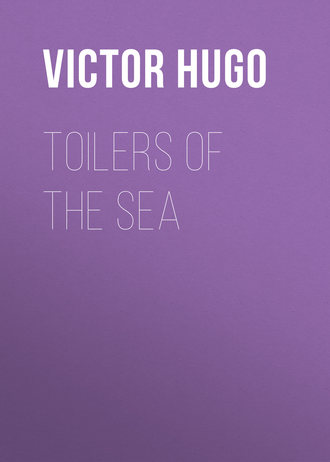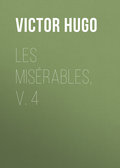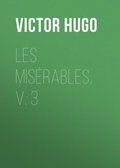
Виктор Мари Гюго
Toilers of the Sea
XI
DISCOVERY
A rock near the coast is sometimes visited by men; a rock in mid-ocean never. What object could any one have there? No supplies can be drawn thence; no fruit-trees are there, no pasturage, no beasts, no springs of water fitted for man's use. It stands aloft, a rock with its steep sides and summits above water, and its sharp points below. Nothing is to be found there but inevitable shipwreck.
This kind of rocks, which in the old sea dialect were called Isolés, are, as we have said, strange places. The sea is alone there; she works her own will. No token of terrestrial life disturbs her. Man is a terror to the sea; she is shy of his approach, and hides from him her deeds. But she is bolder among the lone sea rocks. The everlasting soliloquy of the waves is not troubled there. She labours at the rock, repairs its damage, sharpens its peaks, makes them rugged or renews them. She pierces the granite, wears down the soft stone, and denudes the hard; she rummages, dismembers, bores, perforates, and grooves; she fills the rock with cells, and makes it sponge-like, hollows out the inside, or sculptures it without. In that secret mountain which is hers, she makes to herself caves, sanctuaries, palaces. She has her splendid and monstrous vegetation, composed of floating plants which bite, and of monsters which take root; and she hides away all this terrible magnificence in the twilight of her deeps. Among the isolated rocks no eye watches over her; no spy embarrasses her movements. It is there that she develops at liberty her mysterious side, which is inaccessible to man. Here she keeps all strange secretions of life. Here that the unknown wonders of the sea are assembled.
Promontories, forelands, capes, headlands, breakers, and shoals are veritable constructions. The geological changes of the earth are trifling compared with the vast operations of the ocean. These breakers, these habitations in the sea, these pyramids, and spouts of the foam are the practicers of a mysterious art which the author of this book has somewhere called "the Art of Nature." Their style is known by its vastness. The effects of chance seem here design. Its works are multiform. They abound in the mazy entanglement of the rock-coral groves, the sublimity of the cathedral, the extravagance of the pagoda, the amplitude of the mountain, the delicacy of the jeweller's work, the horror of the sepulchre. They are filled with cells like the wasps' nest, with dens like menageries, with subterranean passages like the haunts of moles, with dungeons like Bastiles, with ambuscades like a camp. They have their doors, but they are barricaded; their columns, but they are shattered; their towers, but they are tottering; their bridges, but they are broken. Their compartments are unaccommodating; these are fitted for the birds only, those only for fish. They are impassable. Their architectural style is variable and inconsistent; it regards or disregards at will the laws of equilibrium, breaks off, stops short, begins in the form of an archivolt, and ends in an architrave, block on block. Enceladus is the mason. A wondrous science of dynamics exhibits here its problems ready solved. Fearful overhanging blocks threaten, but fall not: the human mind cannot guess what power supports their bewildering masses. Blind entrances, gaps, and ponderous suspensions multiply and vary infinitely. The laws which regulate this Babel baffle human induction. The great unknown architect plans nothing, but succeeds in all. Rocks massed together in confusion form a monstrous monument, defy reason, yet maintain equilibrium. Here is something more than strength; it is eternity. But order is wanting. The wild tumult of the waves seems to have passed into the wilderness of stone. It is like a tempest petrified and fixed for ever. Nothing is more impressive than that wild architecture; always standing, yet always seeming to fall; in which everything appears to give support, and yet to withdraw it. A struggle between opposing lines has resulted in the construction of an edifice, filled with traces of the efforts of those old antagonists, the ocean and the storm.
This architecture has its terrible masterpieces, of which the Douvres rock was one.
The sea had fashioned and perfected it with a sinister solicitude. The snarling waters licked it into shape. It was hideous, treacherous, dark, full of hollows.
It had a complete system of submarine caverns ramifying and losing themselves in unfathomed depths. Some of the orifices of this labyrinth of passages were left exposed by the low tides. A man might enter there, but at his risk and peril.
Gilliatt determined to explore all these grottoes, for the purpose of his salvage labour. There was not one which was not repulsive. Everywhere about the caverns that strange aspect of an abattoir, those singular traces of slaughter, appeared again in all the exaggeration of the ocean. No one who has not seen in excavations of this kind, upon the walls of everlasting granite, these hideous natural frescoes, can form a notion of their singularity.
These pitiless caverns, too, were false and sly. Woe betide him who would loiter there. The rising tide filled them to their roofs.
Rock limpets and edible mosses abounded among them.
They were obstructed by quantities of shingle, heaped together in their recesses. Some of their huge smooth stones weighed more than a ton. They were of every proportion, and of every hue; but the greater part were blood coloured. Some, covered with a hairy and glutinous seaweed, seemed like large green moles boring a way into the rock.
Several of the caverns terminated abruptly in the form of a demi-cupola. Others, main arteries of a mysterious circulation, lengthened out in the rock in dark and tortuous fissures. They were the alleys of the submarine city; but they gradually contracted from their entrances, and at length left no way for a man to pass. Peering in by the help of a lighted torch, he could see nothing but dark hollows dripping with moisture.
One day, Gilliatt, exploring, ventured into one of these fissures. The state of the tide favoured the attempt. It was a beautiful day of calm and sunshine. There was no fear of any accident from the sea to increase the danger.
Two necessities, as we have said, compelled him to undertake these explorations. He had to gather fragments of wreck and other things to aid him in his labour, and to search for crabs and crayfish for his food. Shell-fish had begun to fail him on the rocks.
The fissure was narrow, and the passage difficult. Gilliatt could see daylight beyond. He made an effort, contorted himself as much as he could, and penetrated into the cave as far as he was able.
He had reached, without suspecting it, the interior of the rock, upon the point of which Clubin had steered the Durande. Though abrupt and almost inaccessible without, it was hollowed within. It was full of galleries, pits, and chambers, like the tomb of an Egyptian king. This network of caverns was one of the most complicated of all that labyrinth, a labour of the water, the undermining of the restless sea. The branches of the subterranean maze probably communicated with the sea without by more than one issue, some gaping at the level of the waves, the others profound and invisible. It was near here, but Gilliatt knew it not, that Clubin had dived into the sea.
In this crocodile cave – where crocodiles, it is true, were not among the dangers – Gilliatt wound about, clambered, struck his head occasionally, bent low and rose again, lost his footing and regained it many times, advancing laboriously. By degrees the gallery widened; a glimmer of daylight appeared, and he found himself suddenly at the entrance to a cavern of a singular kind.
XII
THE INTERIOR OF AN EDIFICE UNDER THE SEA
The gleam of daylight was fortunate.
One step further, and Gilliatt must have fallen into a pool, perhaps without bottom. The waters of these cavern pools are so cold and paralysing as to prove fatal to the strongest swimmers.
There is, moreover, no means of remounting or of hanging on to any part of their steep walls.
He stopped short. The crevice from which he had just issued ended in a narrow and slippery projection, a species of corbel in the peaked wall. He leaned against the side and surveyed it.
He was in a large cave. Over his head was a roofing not unlike the inside of a vast skull, which might have been imagined to have been recently dissected. The dripping ribs of the striated indentations of the roof seemed to imitate the branching fibres and jagged sutures of the bony cranium. A stony ceiling and a watery floor. The rippled waters between the four walls of the cave were like wavy paving tiles. The grotto was shut in on all sides. Not a window, not even an air-hole visible. No breach in the wall, no crack in the roof. The light came from below and through the water, a strange, sombre light.
Gilliatt, the pupils of whose eyes had contracted during his explorations of the dusky corridor, could distinguish everything about him in the pale glimmer.
He was familiar, from having often visited them, with the caves of Plémont in Jersey, the Creux-Maillé at Guernsey, the Boutiques at Sark; but none of these marvellous caverns could compare with the subterranean and submarine chamber into which he had made his way.
Under the water at his feet he could see a sort of drowned arch. This arch, a natural ogive, fashioned by the waves, was glittering between its two dark and profound supports. It was by this submerged porch that the daylight entered into the cavern from the open sea. A strange light shooting upward from a gulf.
The glimmer spread out beneath the waters like a large fan, and was reflected on the rocks. Its direct rays, divided into long, broad shafts, appeared in strong relief against the darkness below, and becoming brighter or more dull from one rock to another, looked as if seen here and there through plates of glass. There was light in that cave it is true; but it was the light that was unearthly. The beholder might have dreamed that he had descended in some other planet. The glimmer was an enigma, like the glaucous light from the eye-pupil of a Sphinx. The whole cave represented the interior of a death's-head of enormous proportions, and of a strange splendour. The vault was the hollow of the brain, the arch the mouth; the sockets of the eyes were wanting. The cavern, alternately swallowing and rendering up the flux and reflux through its mouth wide opened to the full noonday without, seemed to drink in the light and vomit forth bitterness; a type of some beings intelligent and evil. The light, in traversing this inlet through the vitreous medium of the sea-water, became green, like a ray of starlight from Aldebaran. The water, filled with the moist light, appeared like a liquid emerald. A tint of aqua-marina of marvellous delicacy spread a soft hue throughout the cavern. The roof, with its cerebral lobes, and its rampant ramifications, like the fibres of nerves, gave out a tender reflection of chrysoprase. The ripples reflected on the roof were falling in order and dissolving again incessantly, and enlarging and contracting their glittering scales in a mysterious and mazy dance. They gave the beholder an impression of something weird and spectral: he wondered what prey secured, or what expectation about to be realised, moved with a joyous thrill this magnificent network of living fire. From the projections of the vault, and the angles of the rock, hung lengths of delicate fibrous plants, bathing their roots probably through the granite in some upper pool of water, and distilling from their silky ends one after the other, a drop of water like a pearl. These drops fell in the water now and then with a gentle splash. The effect of the scene was singular. Nothing more beautiful could be imagined; nothing more mournful could anywhere be found.
It was a wondrous palace, in which death sat smiling and content.
XIII
WHAT WAS SEEN THERE; AND WHAT PERCEIVED DIMLY
A place of shade, which yet was dazzling to the eyes – such was this surprising cavern.
The beating of the sea made itself felt throughout the cavern. The oscillation without raised and depressed the level of the waters within, with the regularity of respiration. A mysterious spirit seemed to fill this great organism, as it swelled and subsided in silence.
The water had a magical transparency, and Gilliatt distinguished at various depths submerged recesses, and surfaces of jutting rocks ever of a deeper and a deeper green. Certain dark hollows, too, were there, probably too deep for soundings.
On each side of the submarine porch, rude elliptical arches, filled with shallows, indicated the position of small lateral caves, low alcoves of the central cavern, accessible, perhaps, at certain tides. These openings had roofs in the form of inclined planes, and at angles more or less acute. Little sandy beaches of a few feet wide, laid bare by the action of the water, stretched inward, and were lost in these recesses.
Here and there seaweeds of more than a fathom in length undulated beneath the water, like the waving of long tresses in the wind; and there were glimpses of a forest of sea plants.
Above and below the surface of the water, the wall of the cavern from top to bottom – from the vault down to the depth at which it became invisible – was tapestried with that prodigious efflorescence of the sea, rarely perceived by human eyes, which the old Spanish navigators called praderias del mar. A luxuriant moss, having all the tints of the olive, enlarged and concealed the protuberances of granite. From all the jutting points swung the thin fluted strips of varech, which sailors use as their barometers. The light breath which stirred in the cavern waved to and fro their glossy bands.
Under these vegetations there showed themselves from time to time some of the rarest bijoux of the casket of the ocean; ivory shells, strombi, purple-fish, univalves, struthiolaires, turriculated cerites. The bell-shaped limpet shells, like tiny huts, were everywhere adhering to the rocks, distributed in settlements, in the alleys between which prowled oscabrions, those beetles of the sea. A few large pebbles found their way into the cavern; shell-fish took refuge there. The crustacea are the grandees of the sea, who, in their lacework and embroidery, avoid the rude contact of the pebbly crowd. The glittering heap of their shells, in certain spots under the wave, gave out singular irradiations, amidst which the eye caught glimpses of confused azure and gold, and mother-of-pearl, of every tint of the water.
Upon the side of the cavern, a little above the water-line, a magnificent and singular plant, attaching itself, like a fringe, to the border of seaweed, continued and completed it. This plant, thick, fibrous, inextricably intertwined, and almost black, exhibited to the eye large confused and dusky festoons, everywhere dotted with innumerable little flowers of the colour of lapis-lazuli. In the water they seemed to glow like small blue flames. Out of the water they were flowers; beneath it they were sapphires. The water rising and inundating the basement of the grotto clothed with these plants, seemed to cover the rock with gems.
At every swelling of the wave these flowers increased in splendour, and at every subsidence grew dull again. So it is with the destiny of man; aspiration is life, the outbreathing of the spirit is death.
One of the marvels of the cavern was the rock itself. Forming here a wall, there an arch, and here again a pillar or pilaster, it was in places rough and bare, and sometimes close beside, was wrought with the most delicate natural carving. Strange evidences of mind mingled with the massive stolidity of the granite. It was the wondrous art-work of the ocean. Here a sort of panel, cut square, and covered with round embossments in various positions, simulated a vague bas-relief. Before this sculpture, with its obscure designs, a man might have dreamed of Prometheus roughly sketching for Michael Angelo. It seemed as if that great genius with a few blows of his mallet could have finished the indistinct labours of the giant. In other places the rock was damasked like a Saracen buckler, or engraved like a Florentine vase. There were portions which appeared like Corinthian brass, then like arabesques, as on the door of a mosque; then like Runic stones with obscure and mystic prints of claws. Plants with twisted creepers and tendrils, crossing and recrossing upon the groundwork of golden lichens, covered it with filigree. The grotto resembled in some wise a Moorish palace. It was a union of barbarism and of goldsmith's work, with the imposing and rugged architecture of the elements.
The magnificent stains and moulderings of the sea covered, as with velvet, the angles of granite. The escarpments were festooned with large-flowered bindweed, sustaining itself with graceful ease, and ornamenting the walls as by intelligent design. Wall-pellitories showed their strange clusters in tasteful arrangement. The wondrous light which came from beneath the water, at once a submarine twilight and an Elysian radiance, softened down and blended all harsh lineaments. Every wave was a prism. The outlines of things under these rainbow-tinted undulations produced the chromatic effects of optical glasses made too convex. Solar spectra shot through the waters. Fragments of rainbows seemed floating in that transparent dawn. Elsewhere – in other corners – there was discernible a kind of moonlight in the water. Every kind of splendour seemed to mingle there, forming a strange sort of twilight. Nothing could be more perplexing or enigmatical than the sumptuous beauties of this cavern. Enchantment reigned over all. The fantastic vegetation, the rude masonry of the place seemed to harmonise. It was a happy marriage this, between these strange wild things. The branches seeming but to touch one another clung closely each to each. The stern rock and the pale flower met in a passionate embrace. Massive pillars had capitals and entwining wreaths of delicate garlands, that quivered through every fibre, suggestive of fairy fingers tickling the feet of a Behemoth, and the rock upheld the plant, and the plant clasped the rock with unnatural joy of attraction.
The effect produced by the mysterious reconciliation of these strange forms was of a supreme and inexpressible beauty.
The works of nature, not less than the works of genius, contain the absolute, and produce an impression of awe. Something unexpected about them imperiously insists on our mental submission; we are conscious of a premeditation beyond our human scope, and at no time are they more startling than when we suddenly become aware of the beauty that is mingled with their terror.
This hidden grotto was, if we may use the expression, siderealised. There was everything in it to surprise and overwhelm. An apocalyptic light illuminated this crypt. One could not tell if that which the eyes looked upon was a reality, for reality bore the impress of the impossible. One could see, and touch, and know that one was standing there, and yet it was difficult to believe in it all.
Was it daylight which entered by this casement beneath the sea? Was it indeed water which trembled in this dusky pool? Were not these arched roofs and porches fashioned out of sunset clouds to imitate a cavern to men's eyes? What stone was that beneath the feet? Was not this solid shaft about to melt and pass into thin air? What was that cunning jewellery of glittering shells, half seen beneath the wave? How far away were life, and the green earth, and human faces? What strange enchantment haunted that mystic twilight? What blind emotion, mingling its sympathies with the uneasy restlessness of plants beneath the wave?
At the extremity of the cavern, which was oblong, rose a Cyclopean archivolte, singularly exact in form. It was a species of cave within a cave, of tabernacle within a sanctuary. Here, behind a sheet of bright verdure, interposed like the veil of a temple, arose a stone out of the waves, having square sides, and bearing some resemblance to an altar. The water surrounded it in all parts. It seemed as if a goddess had just descended from it. One might have dreamed there that some celestial form beneath that crypt or upon that altar dwelt for ever pensive in naked beauty, but grew invisible at the approach of mortals. It was hard to conceive that majestic chamber without a vision within. The day-dream of the intruder might evoke again the marvellous apparition. A flood of chaste light falling upon white shoulders scarcely seen; a forehead bathed with the light of dawn; an Olympian visage oval-shaped; a bust full of mysterious grace; arms modestly drooping; tresses unloosened in the aurora; a body delicately modelled of pure whiteness, half-wrapped in a sacred cloud, with the glance of a virgin; a Venus rising from the sea, or Eve issuing from chaos; such was the dream which filled the mind.
It seemed improbable that no phantom figure haunted this abode. Some woman's form, the embodiment of a star, had no doubt but shortly left the altar. Enveloped in this atmosphere of mute adoration the mind pictured an Amphitryon, a Tethys, some Diana capable of passion, some idealistic figure formed of light, looking softly down in the surrounding dusk. It was she who had left behind in the cave this perfumed luminosity, an emanation from her star-body. The dazzling phantom was no longer visible, she was only revealed by the invisible, and the sense of her presence lingered, setting the whole being voluptuously a-quiver. The goddess had departed, but divinity remained.
The beauty of the recess seemed made for this celestial presence. It was for the sake of this deity, this fairy of the pearl caverns, this queen of the Zephyrs, this Grace born of the waves, it was for her – as the mind, at least, imagined – that this subterranean dwelling had been thus religiously walled in, so that nothing might ever trouble the reverent shadows and the majestic silence round about that divine spirit.
Gilliatt, who was a kind of seer amid the secrets of nature, stood there musing, and sensible of confused emotions.
Suddenly, at a few feet below him, in the delightful transparence of that water like liquid jewels, he became sensible of the approach of something of mystic shape. A species of long ragged band was moving amidst the oscillation of the waves. It did not float, but darted about of its own will. It had an object; was advancing somewhere rapidly. The object had something of the form of a jester's bauble with points, which hung flabby and undulating. It seemed covered with a dust incapable of being washed away by the water. It was more than horrible; it was foul. The beholder felt that it was something monstrous. It was a living thing; unless, indeed, it were but an illusion. It seemed to be seeking the darker portion of the cavern, where at last it vanished. The heavy shadows grew darker as its sinister form glided into them, and disappeared.







